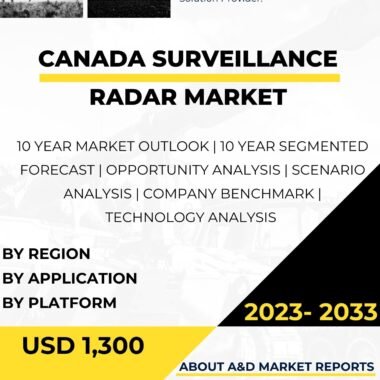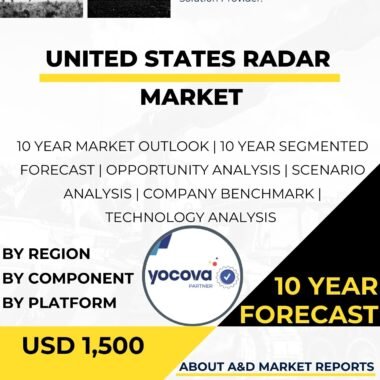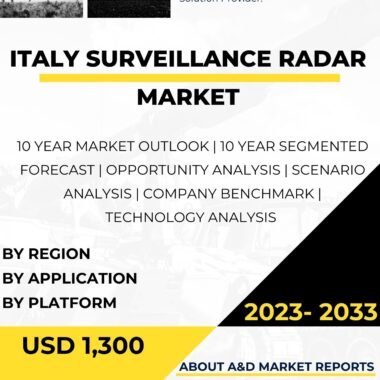Description
The Surveillance Radar market in Australia plays a crucial role in the country’s defense and security by providing advanced radar systems for surveillance, reconnaissance, and airspace monitoring. Radar, an acronym for Radio Detection and Ranging, is a technology that uses radio waves to detect and track objects in the air, on land, and at sea. This article provides a comprehensive overview of the Australia Surveillance Radar market, including its significance, current applications, major players, technological advancements, government initiatives, civilian applications, and future prospects.
The significance of the Surveillance Radar market in Australia lies in its critical role in maintaining the country’s situational awareness, airspace security, and early warning capabilities. As a vast continent with a diverse geography and extensive coastline, Australia faces a range of security challenges, including territorial protection, maritime surveillance, and aerial defense. Surveillance radars play a pivotal role in providing timely and accurate information to the Australian Defence Force (ADF) and other government agencies, enabling them to detect, track, and respond to potential threats and security breaches.
The Australia Surveillance Radar market encompasses various types of radar systems, including air surveillance radars, maritime surveillance radars, ground surveillance radars, and weather surveillance radars. Each type of radar is designed to operate in specific environments and provide relevant data to support defense and security operations.
The current applications of Surveillance Radars in Australia include air defense, maritime domain awareness, border surveillance, airspace management, weather monitoring, and disaster response. Air surveillance radars are used to detect and track aircraft, drones, and other aerial threats, providing critical data for air defense operations and airspace management.
Maritime surveillance radars monitor Australia’s extensive coastline and maritime territories, detecting and tracking vessels and potential maritime threats, such as illegal fishing, smuggling, and maritime security breaches.
Ground surveillance radars are utilized for border security and monitoring of land-based activities. These radars support law enforcement and military operations in detecting intrusions, monitoring critical infrastructure, and countering illicit activities along Australia’s land borders.
Weather surveillance radars are instrumental in monitoring and forecasting weather patterns, including severe weather events such as storms and cyclones. These radars provide valuable information for disaster response and relief efforts.
The Australia Surveillance Radar market is served by both domestic and international players. Domestic companies, such as CEA Technologies and BAE Systems Australia, are actively involved in the development, manufacturing, and supply of surveillance radar systems for the ADF and other government agencies.
International defense contractors, including Lockheed Martin, Raytheon, and Thales, also have a presence in the Australian market, providing a range of radar solutions and technology.
Technological advancements drive innovation in the Australia Surveillance Radar market. Research and development efforts focus on improving radar resolution, range, sensitivity, and integration with other sensor systems.
The development of Active Electronically Scanned Array (AESA) technology has revolutionized radar systems, enabling faster scanning, improved target detection, and reduced electronic countermeasures susceptibility.
Integration of multi-sensor data fusion capabilities allows for comprehensive situational awareness, combining data from different radar systems, electro-optical sensors, and other sources to provide a unified picture of the operational environment.
Moreover, the miniaturization of radar systems and the use of unmanned platforms, such as drones and unmanned aerial vehicles (UAVs), expand the surveillance capabilities and flexibility of radar operations.
Looking ahead, the Australia Surveillance Radar market is expected to witness continued growth and investment. As defense and security threats evolve, there will be opportunities for domestic and international companies to collaborate on research, development, and production of advanced Surveillance Radar systems.
Government initiatives aimed at strengthening Australia’s defense industry and supporting local manufacturing will drive investments in radar technologies and supply chain development.
In addition to defense and security applications, there are potential civilian applications for Surveillance Radar technology in Australia. For instance, weather surveillance radars can be adapted for civilian weather monitoring and forecasting services, supporting disaster preparedness and response efforts.
However, it is essential to ensure that any civilian applications of surveillance radar technology adhere to safety regulations and privacy considerations to prevent misuse and safeguard personal data.
In conclusion, the Australia Surveillance Radar market is of critical importance in maintaining the country’s defense and security capabilities. Surveillance radars provide essential information for air defense, maritime domain awareness, border surveillance, and disaster response, supporting Australia’s efforts to safeguard its airspace, territorial integrity, and national security.
Domestic and international companies contribute to the diverse offerings in the market, driven by technological advancements in radar resolution, data fusion, and sensor integration.
Continued investments in research, development, and collaboration will be instrumental in maintaining Australia’s credible and effective Surveillance Radar capabilities.
As the ADF and government agencies seek to address emerging security challenges and surveillance requirements, the demand for advanced radar systems and emerging technologies will shape the future of the Australia Surveillance Radar market, positioning the country as a key player in the global defense and security industry. Collaborations between government agencies, industry stakeholders, and international partners will be crucial in further improving the effectiveness and efficiency of Surveillance Radar operations in Australia.




